Caballero B. (ed.) Encyclopaedia of Food Science, Food Technology and Nutrition. Ten-Volume Set
Подождите немного. Документ загружается.

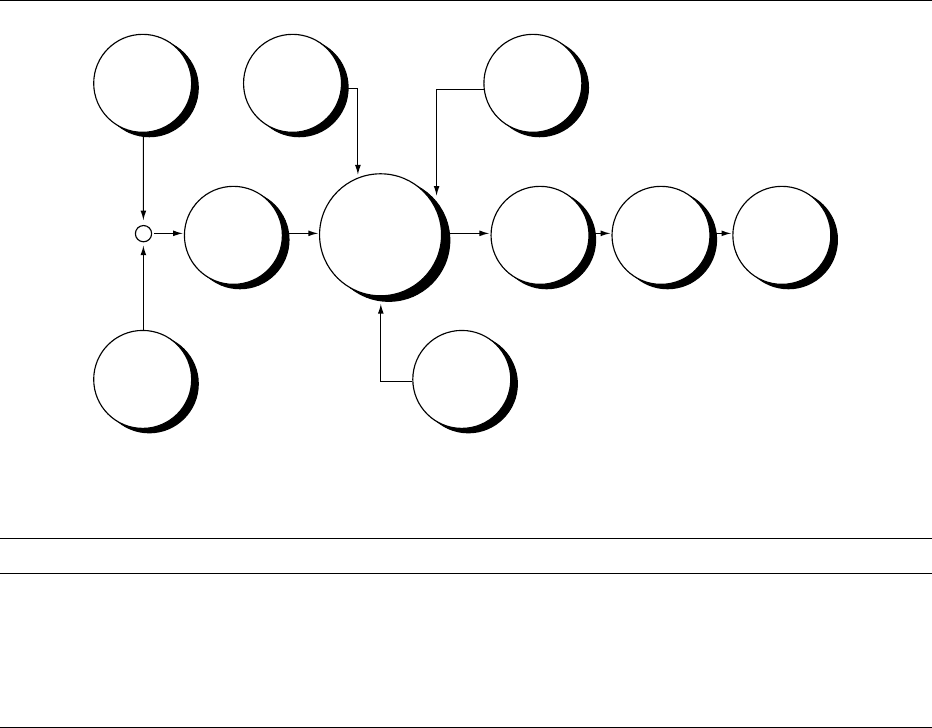
by carrying out a polymerization reaction at solid/gas
or liquid/gas interfaces.
0010 No encapsulation process developed to date is able
to produce the full range of capsules desired by po-
tential capsule users. Some processes readily produce
small, liquid-filled capsules, whereas others produce
relatively large capsules with a solid core material,
capsules with water-soluble shells, or capsules with
water-insoluble shells. In order to provide insight into
which process is most appropriate for a specific food
application, features of Type A and B encapsulation
processes used by the food industry are summarized
in the following sections. Processes that produce cap-
sules not approved for food applications are discussed
elsewhere.
Type A Encapsulation Processes
0011 Complex coacervation Complex coacervation is a
phenomenon in which cationic and anionic water-
soluble polymers interact in water to form a liquid,
polymer-rich phase called a complex coacervate. This
coacervate is used to form a microcapsule shell (see
Figure 3). Gelatin is normally the cationic polymer
used. A variety of natural and synthetic anionic water-
soluble polymers interact with gelatin to form a com-
plex coacervate, but the food industry appears to use
gum arabic exclusively. When the complex coacervate
forms, it is in equilibrium with a dilute solution called
the supernatant. The supernatant acts as the continu-
ous phase in which the complex coacervate is dis-
persed. If a water-insoluble core material such as a
flavor or fat is dispersed in the system, each droplet or
particle of dispersed core material is spontaneously
coated with a thin film of coacervate provided that
the coacervate adsorbs on the surface of the dispersed
oil droplets. When this liquid film is gelled, capsules
are formed. The ‘wet’ complex coacervate gel is a
very rubbery shell that deforms extensively without
rupturing. In order to increase the strength of the
water-swollen shell and create a gel structure that is
not thermally reversible, complex coacervate capsules
shells are typically cross-linked with glutaraldehyde.
0012Complex coacervation encapsulation processes can
encapsulate many water-immiscible oils such as vita-
mins, plant oils and flavors as well as water-insoluble
solids. Such processes routinely produce single cap-
sules 20–800 mm in diameter that contain 80–90 wt.%
core material. Capsules outside these size and core
Aqueous
gelatin
solution
(40−60⬚C)
Aqueous
gum arabic
solution
(40−60⬚C)
Adjust pH
(e.g., 4.0−4.6)
Water-
immiscible
oil
Water
(40−60⬚C)
Cool
(to gel
coacervate)
Oil-in-water
emulsion
Mixer
Mixer
Crosslink
Harvest
microcapsules
fig0003 Figure 3 Sequence of steps of a complex coacervation encapsulation process. Courtesy Thies Technology.
tbl0002 Table 2 Representative examples of two broad classes of encapsulation processes
TypeA processes Type B processes
Complex coacervation Spray drying and spray chilling
Polymer/polymer incompatibility Fluidized bed
Interfacial polymerization at liquid/liquid and solid/liquid interfaces Interfacial polymerization at solid/gas of Liquid/gas interfaces
In-situ polymerization Centrifugal extrusion
Solvent evaporation or in-liquid drying Extrusion or spraying into a desolvation bath
Submerged nozzle extrusion Rotational suspension separation (spinning disk)
Melt spinning
3894 MICROCAPSULES
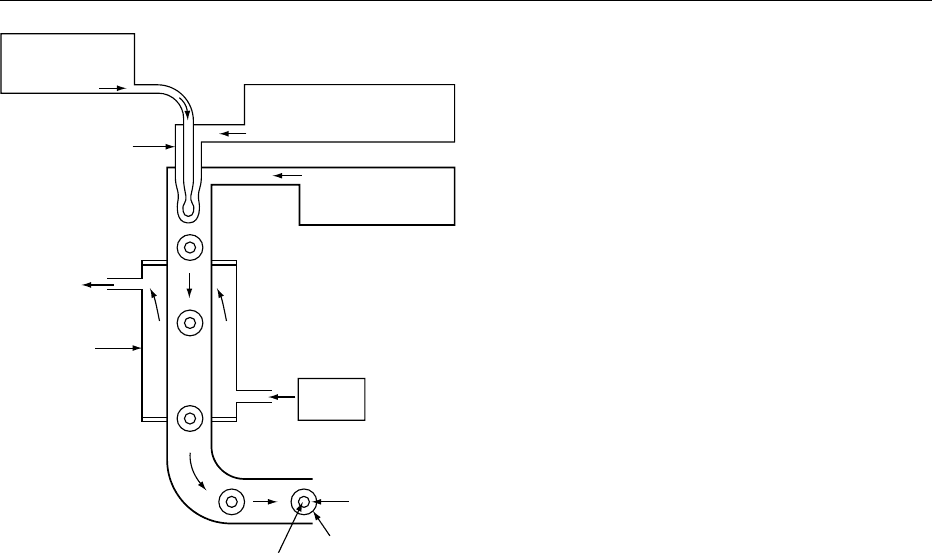
content ranges can be produced, although consider-
able experience may be required. Most coacervate
capsules approach the continuous core/shell structure
shown in Figure 2a, but the shell may not have a
uniform thickness. Complex coacervation processes
are adversely affected by active agents that have a
finite water solubility, are surface active, or are detri-
mentally affected by pH conditions used to produce
the microcapsules. The shell of dry complex coacer-
vate capsules is sensitive to variations in atmospheric
moisture content and becomes plasticized at a relative
humidity of 70% or higher. Thus, the release proper-
ties of a complex coacervate capsule can be affected
significantly by environmental conditions to which
the capsules are exposed during storage.
0013 Submerged centrifugal force and nozzle processes
Several Type A processes use submerged centrifugal
force or nozzles to form microcapsules (see Figure 4).
The nozzles can be rotating, stationary, or vibrating.
They may be single or multifluid nozzles. An example
of the former is the spinning cup encapsulation ap-
paratus developed by the Atlantic Coast Fisheries
Company. This consists of a spinning cup that con-
tains a row of small holes. When the cup is immersed
in a container filled with mineral oil or vegetable oil,
an oil-in-water (o/w) emulsion fed into the interior of
this spinning cup is extruded dropwise by centrifugal
force through the openings into the oil phase that
surrounds it. This creates a suspension of o/w emul-
sion droplets suspended in an oil phase. The continu-
ous phase of these droplets is an aqueous solution of a
polymer that gels on cooling (e.g., gelatin), whereas
the dispersed phase is a water-immiscible liquid like a
vitamin or fish oil. As the extruded droplets sink in
the oil phase, the aqueous phase of the emulsion gels
thereby creating gel beads throughout which an oil
such as a vitamin or fish oil is dispersed. The beads
are harvested from the oil phase by a solvent wash
and dried. The dried beads have the structure shown
in Figure 2b (see Figure 5).
0014Various submerged stationary and vibrating
nozzles are used to produce microcapsules. A number
of different nozzle configurations exist, and these
produce capsules with a variety of structures. Sophis-
ticated multifluid vibrating nozzles have been incorp-
orated into capsule production units. Such units
typically produce microcapsules by coextruding an
aqueous polymer solution that gels on cooling and
an oil to be encapsulated into a third or suspending
fluid. The suspending fluid is a cooled oil phase in
which the aqueous polymer solution gels, thereby
forming gel beads with a continuous core/shell struc-
ture, as shown in Figure 2a. Such beads are isolated
from the suspending fluid, washed in order to remove
residual oil from the suspending medium, and subse-
quently dried.
0015To date, submerged Type A centrifugal force and
various nozzle encapsulation processes are used pri-
marily for the encapsulation of a variety of water-
immiscible oils. The capsules tend to be larger than
250–500 mm but are typically formed from food-
grade shell materials that can be gelled thermally.
Type B Encapsulation Processes
0016General comments Type B encapsulation processes
utilize centrifugal force, extrusion, coextrusion, and
spray technology in order to produce microcapsules.
They predate Type A encapsulation processes, since
spray drying encapsulation was developed in the
1930s. This class of encapsulation processes generally
utilizes self-contained encapsulation units marketed by
equipment manufacturers. In contrast, equipment for
Type A encapsulation processes is typically custom-
designed and manufactured for a specific capsule pro-
ducer. It is the author’s opinion that Type B processes
often cannot produce microcapsules < 100 mmeconom-
ically, whereas many Type A processes can. A notable
exception is spray drying. Other exceptions undoubt-
edly exist, but there is clearly a question of how well
many current Type B processes function when an effort
is made to use them to produce economically viable
amounts of small (e.g., < 100 mm) microcapsules.
Shell material
(e.g., warm gelatin solution)
Warm carrier phase
(e.g., vegetable oil)
Core material
(e.g., vitamin oil)
2-Fluid
nozzle
Cooling
coil
Coolant
Core
material
Gelled shell
material
Gel beads that
can be harvested
and dried
fig0004 Figure 4 Stationary two-fluid nozzle used to produce capsules.
MICROCAPSULES 3895
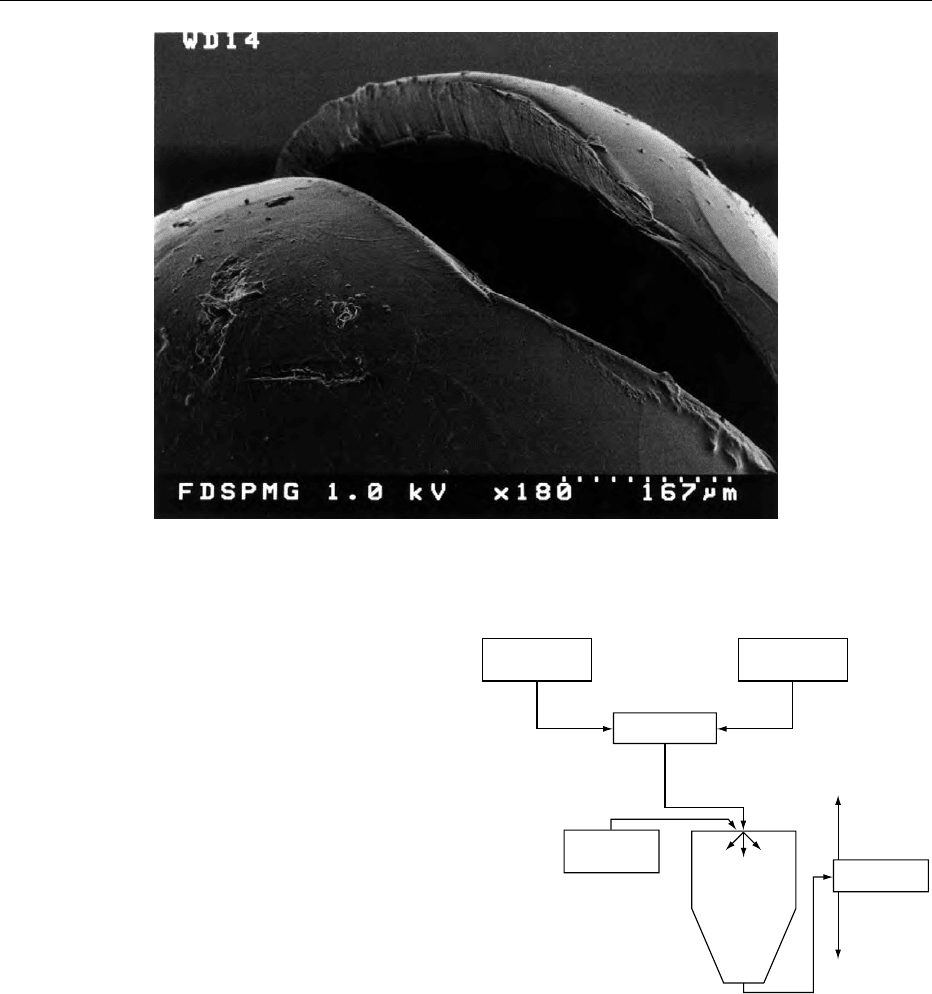
0017 Spray drying Spray drying is used to produce a var-
iety of encapsulated food components. The first step
is to emulsify the core material, typically a water-
immiscible flavor, vitamin, fish or plant oil, in a con-
centrated (35–60 wt.%) aqueous solution of shell
material until 1–3 mm oil droplets are obtained. The
shell material normally is a water-soluble material
like gum arabic, maltodextrin (hydrolyzed starch),
modified starch, hydrolyzed gelatin, sugars, or vari-
ous mixtures of these materials. All are approved for
food use. They are water-soluble and not chemically
cross-linked. Capsules prepared from them dissolve
in water and release core material without leaving
any residual capsule shell debris. Figure 6 illustrates
the steps involved in the process. (See Drying: Spray
Drying.)
0018 Once a suitable core material/shell material disper-
sion has been prepared, the resulting emulsion is fed
as droplets into the heated chamber of a spray drier.
The droplets are rapidly dehydrated, thereby produ-
cing dry capsules that fall to the bottom of the drying
chamber where they are harvested. Capsules pro-
duced in this manner are typically 10–300 mmin
diameter. They may have an irregular geometry and
be aggregates of a number of small particles. Spray-
dried capsules contain a number of small droplets of
core material dispersed throughout it, as illustrated in
Figure 2b.
0019 Spray-dry encapsulation has a number of advan-
tages:
1.
0020It is a well-established technology.
2.
0021It utilizes readily available equipment.
3.
0022It can produce large amounts of capsules econom-
ically.
It also has several limitations. For example, the list of
candidate water-soluble shell materials is limited to
candidate materials that form concentrated (30–
60 wt.% solids) aqueous solutions of sufficient low
viscosity that they can be pumped. Another limitation
Separator
Atomization
Drying
chamber
Heated
gas
Homogenize
Solvent +
shell material
Core
material
Dry
capsule
powder
Solvent vapor
and
exhaust gas
fig0006Figure 6 Steps involved in a spray-drying encapsulation
process.
fig0005 Figure 5 Scanning electron photomicrograph of a cut flavor capsule produced by a submerged nozzle encapsulation apparatus.
Magnification: 180 . Courtesy Thies Technology.
3896 MICROCAPSULES
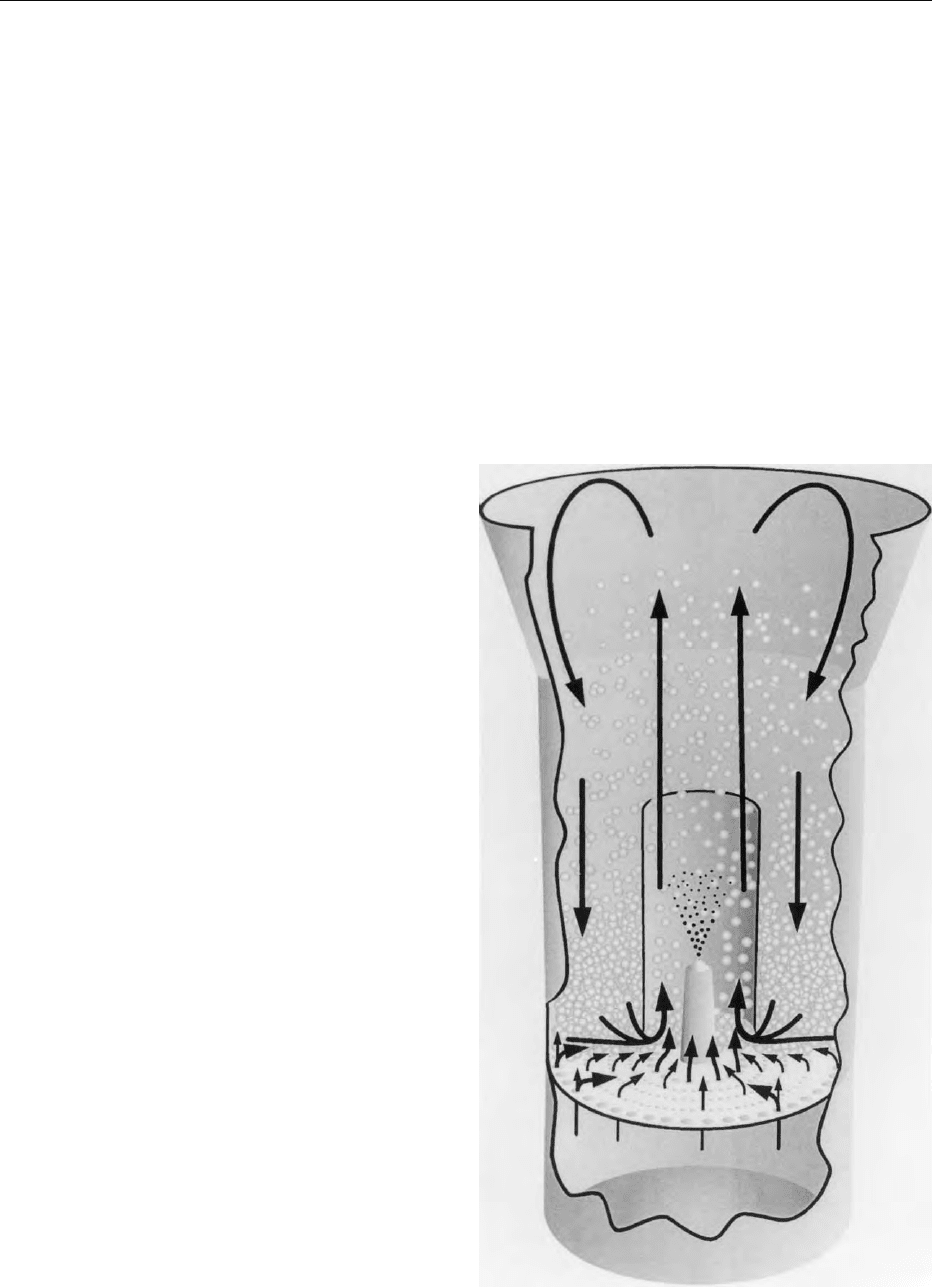
is the 20–30% core loading carried by most spray-
dried capsules. Spray-drying protocols that allow
core loading up to 50–60% have been reported, but
current spray-dried capsules carry a lower loading. A
persistent problem with spray-dried capsules is free or
surface core material. Because water evaporation
from a capsule in the chamber of a spray drier occurs
rapidly, it is not uncommon to harvest spray-dried
capsules that have a significant amount of free or
unencapsulated oil. This free oil exists because of
discontinuities in the capsule shell, some of which
form as a result rapid evaporation of water from the
droplets being dried, thereby forming microcapsules.
The higher the core loading, the more pronounced
this problem can become. Free or surface oil is un-
desirable, since it is susceptible to oxidation and de-
velopment of an off-odor or off-taste when the
encapsulated core material is a fragrance or a flavor,
respectively. It has been found that maximizing core
loading and minimizing free core content involve a
judicious choice of coating material, emulsifying
agent, and spray-dryer operating conditions. Finally,
it is important to stress that low-boiling-point com-
pounds with a finite degree of water solubility have
posed a persistent problem to spray-drying encapsu-
lation. Such compounds volatilize from the capsules
in the spray-drying chamber.
0023 In summary, spray drying is a viable commercial
method of forming microcapsules for the food indus-
try. It is an established, comparatively low-cost en-
capsulation technology that continues to develop. To
date, spray drying for food products has primarily
been used to encapsulate flavors, various fish and
plant oils as well as liquid vitamins.
0024 Spray chilling Spray chilling, cooling, or congealing
are variations of conventional spray-drying. In these
cases, chilled air is used to solidify molten capsule
shell material formulations rather than volatilize a
solvent. Various fats, waxes, fatty alcohols, fatty
acids, or combinations of these materials are the
shell materials used. In such encapsulation proced-
ures, the active agent is dispersed in a molten shell
material with the aid of an emulsifier, if necessary.
The resulting dispersion is atomized through heated
nozzles into a cooling chamber analogous to that used
in a spray drier. The shell material is solidified by
cooling, thereby producing solid particles.
0025 Particles produced by this method have water-
insoluble shells. The processing temperature has an
influence on shell material polymorphism, a phenom-
enon that is characteristic of many fats. If poly-
morphic changes in a fat coating occur on storage,
such changes can have a significant negative effect on
capsule storage and release properties.
0026Fluidized-bed coaters Fluidized-bed coaters func-
tion by suspending a bed or column of solid particles
in a moving gas stream, usually air. Three types of
fluidized beds are available: top-spray, tangential-
spray, and bottom-spray (see Figure 7). These units
differ in location of the nozzle or nozzles used to
apply the coating formulation. Nevertheless, in each
case, a liquid coating formulation is sprayed on to the
individual suspended particles, and the freshly coated
particles are cycled into a zone where the coating
formulation is solidified either by solvent evaporation
or by cooling. This coating and drying sequence may
be repeated until a desired coating thickness has been
applied. (See Drying: Fluidized-bed Drying.)
0027In a bottom- or tangential-spray unit, droplets of
liquid coating material leaving a spray nozzle move
fig0007Figure 7 Bottom spray or Wurster fluidized-bed coating appar-
atus. Courtesy Coating Place, Verona, WI.
MICROCAPSULES 3897
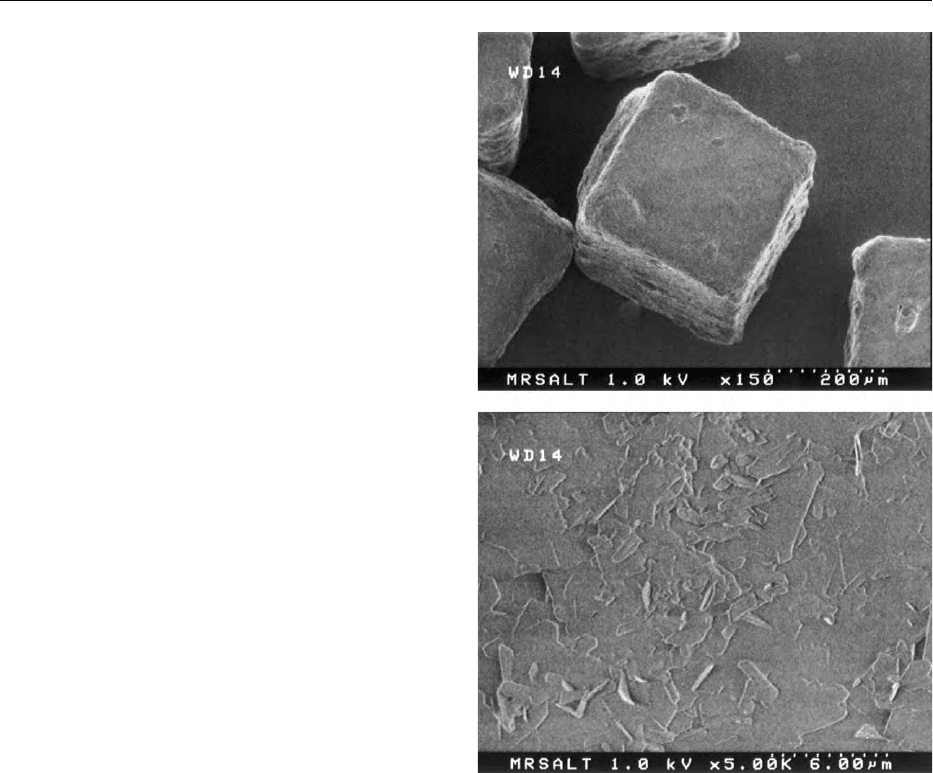
concurrent with the gas stream used to suspend the
bed of solid particles being coated. In a top-spray
unit, the coating formulation is sprayed down on
and into the top of the fluidized bed. The droplets of
spray leaving the nozzle move countercurrent to the
gas stream until they impact the particles being
coated. In the former case, a uniform film of coating
material can be deposited when the coating formula-
tion contains a volatile solvent. In the latter case,
volatile solvent(s) in the coating formulation can
evaporate from the spray droplets, thereby increasing
the solids content, perhaps to such a degree that they
cannot spread on to the particles being coated. This
spray-drying effect has been used to explain why
solvent-based coating formulations applied in top-
spray fluidized bed coaters often yield coated par-
ticles with a degree of internal void volume and
porous coatings. Enteric coatings applied as aqueous
latex dispersions are an exception. Such coatings ap-
plied in a top-spray fluidized-bed coater form a con-
tinuous coating analogous to that obtained with
tangential- and bottom-spray units. Molten fats also
can be applied by top-spray units, since, in such cases,
there is no solvent evaporation. Although top-spray
units have limitations, they are claimed to be simpler
to operate and have a higher production capacity
than the other types of units.
0028 Application of the capsule shell material in a series
of steps, as is typically done in a fluidized-bed coating
process, is both an advantage and a disadvantage.
The advantage is that sequential deposition of the
shell formulation in a number of different cycles
covers up or heals defects found in any single applica-
tion, thereby yielding relatively defect-free coatings.
It is also possible to coat layers of different shell
materials on a particle surface. The disadvantage is
that it takes time to apply the capsule shell in a series
of cyclical steps, and this increases the operating
costs.
0029 Fluidized-bed coaters can encapsulate only solid
particles or perhaps porous particles into which a
liquid has been absorbed. However, no other encap-
sulation technology can apply as broad a range of
shell materials: hot melts, aqueous latex dispersions,
organic solvent solutions, or aqueous solutions.
Several commercial organizations use fluidized-bed
coaters to coat various solid food ingredients with
fats (see Figure 8). This appears to be the primary
use of fluidized-bed coaters by the food industry.
0030 Desolvation or liquid extraction encapsulation tech-
nology Desolvation encapsulation processes consist
of dissolving a shell formulation in a finite amount of
water, thereby forming a concentrated solution (e.g.,
40 wt.%) of shell material. Core material is dispersed
in this solution with the aid of a surfactant. The
dispersion produced can be extruded or atomized
directly into a desolvation bath (Figure 9) that solidi-
fies the shell formulation by extracting the solvent
used to dissolve the shell material from the spray
droplets. Alternately, the core material/shell disper-
sion can be extruded or atomized into a vessel that
contains excess spinning solvent. The spinning bath
produces droplets of core/shell formulation that
are subsequently solidified in a desolvation bath.
Capsules with a relatively low core loading (e.g.,
15–20%) are produced, although more recent patents
indicate that a core loading up to 40% is feasible.
0031The core material is generally a water-immiscible
liquid such as a flavor. The shell material can be vari-
ous combinations of carbohydrate(s) or protein(s).
Spinning solvents (e.g., mineral or vegetable oil) are
immiscible with the shell material solvent (water).
fig0008Figure 8 Scanning electron photomicrographs of a single NaCl
crystal coated with a fat by a fluidized-bed coating process: top,
150 magnification; bottom, 5000 magnification. Courtesy
Thies Technology.
3898 MICROCAPSULES
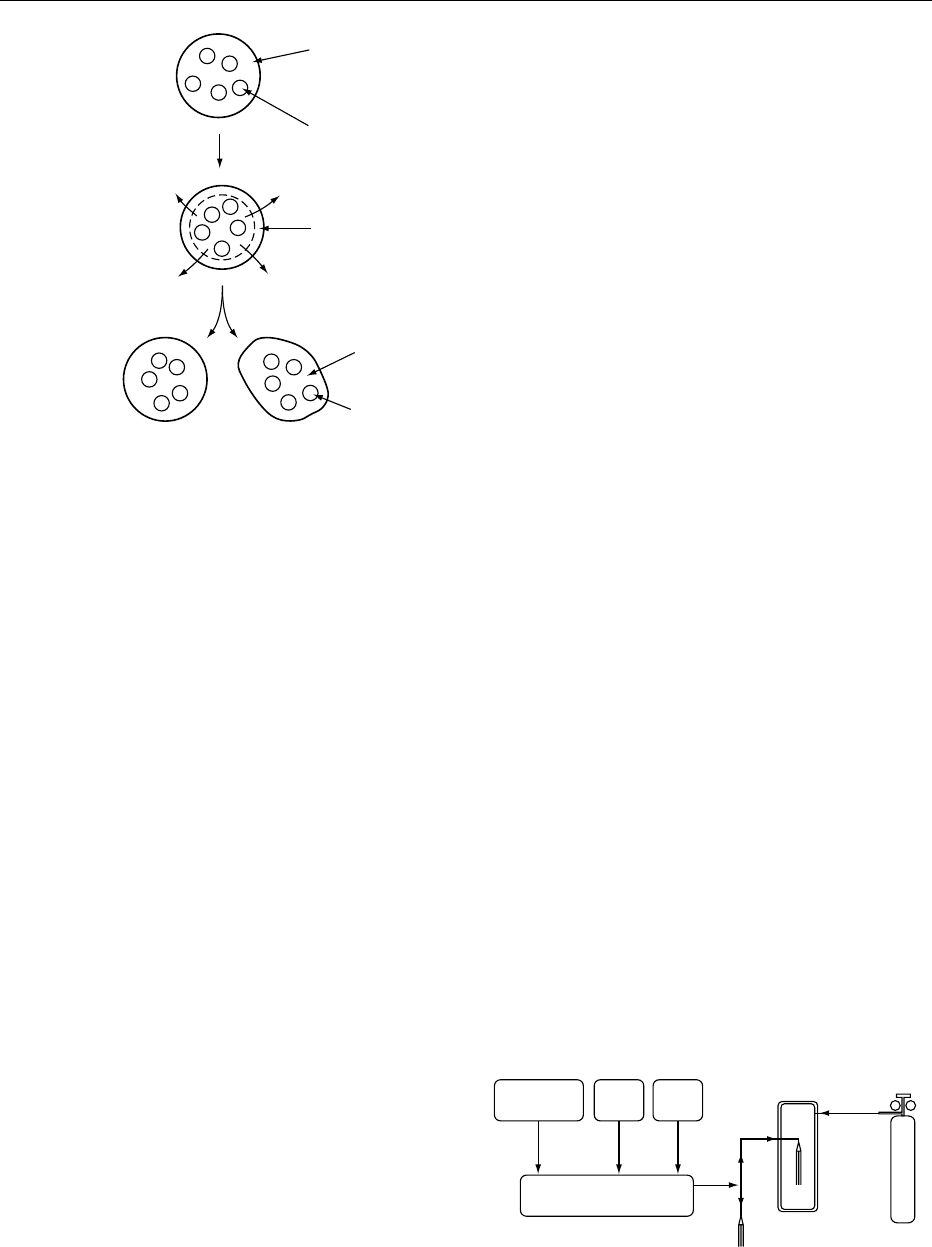
Water-miscible desolvation solvents (e.g., isopropa-
nol, ethanol) are nonsolvents for the shell material (s).
The desolvation solvent, often cooled, extracts water
from the shell formulation, thereby producing solid
particles or rods. Residual desolvation solvent is re-
moved from solidified particles by drying. Rods or
strands of solidified extrudate can be broken up into
small particles by agitation in the extraction vessel or
after isolation.
0032 For this encapsulation technology to be successful,
the desolvation solvent must be able to extract solvent
(e.g., water) from the dispersed core/shell formulation
with minimal simultaneous leaching of core material
from the formulation. This occurs if the desolvation
solvent rapidly solidifies the outer surface region of
core/shell formulation droplets or rods to form an
outer barrier that prevents diffusion of core material
into the extraction solvent, but allows diffusion of
water from the interior of the droplets to the extrac-
tion medium.
0033 Desolvation encapsulation technology can produce
water-soluble food-grade capsules loaded with a
range of flavors. Typical shell materials include edible
water-soluble materials like gum arabic, maltodex-
trins, or modified starches (i.e., the same materials
used in spray drying). This technology can be carried
out in an inert atmosphere and at reduced tempera-
tures, thereby minimizing loss or degradation of
sensitive components. It can incorporate water sol-
uble materials in water-soluble shells and produce
stable capsules free of unencapsulated core material,
since the desolvating liquid extracts actives from
defective capsules.
0034 Problems with this technology include the use of
solvents other than water that are more costly than
heated air, are flammable, must be recycled, and must
be essentially eliminated from the final product. Des-
olvating liquids also can break core/shell material
emulsions, thereby preventing suitable particle for-
mation. The formation of stable emulsions in concen-
trated aqueous shell solutions can pose serious
problems, especially if they are heated.
0035Melt extrusion A melt extrusion encapsulation pro-
cess (Figure 10) involves dispersing a core material in
a molten shell formulation at 85–125
C with or
without the aid of a surfactant. Once formed, the
dispersion is extruded as filaments into a relatively
cool environment that solidifies the extruded mass.
The receiving environment can be a gas phase or a
tank that contains a suitable solvent. If extruded into
a gas phase, the cooled mass is simply broken up into
particles and used. If extruded into a solvent (e.g.,
20
C isopropanol), the solvent simultaneously
cools and removes unencapsulated or free core mater-
ial from the filaments. The solidified product is
subsequently dried and broken up to yield particles
with the multinuclear structure shown in Figure 11.
The particles are glass matrices loaded with dis-
persed core material. Flavor-loaded particles pro-
duced in this manner have an excellent resistance to
oxidation during storage. An anticaking agent like
pyrogenic silica can be added to enhance particle
flow properties. (See Extrusion Cooking: Principles
and Practice.)
0036The patent literature discloses a number of melt
extrusion methods and combinations of shell mater-
ials used to produce particles loaded with a core
material. Claimed core loading in the final product
ranges from 5 to 40% of final particle weight, al-
though a loading of 5–30% is most common. Pre-
ferred core materials are flavoring oils. Both oil- and
water-miscible flavors have been entrapped. The
core/shell formulation typically has a temperature of
125
C at the time of extrusion. An antioxidant
Desolvated
shell material
Core
material
Skin of desolvated
shell material
Core material
Solution of
shell material
Solvated
'particle'
Desolvating
liquid
Desolvated
particle
Solvent
Solvent
or
Solvent
Solvent
fig0009 Figure 9 Sequence of steps that occur in a desolvation bath.
Extrusion into atmosphere or
isopropanol
Pressure vessel
(for pressurized
extrusion/cooling)
Extruder
Matrix
ingredients
Water Flavor
N
2
fig0010Figure 10 Melt extrusion encapsulation process. Courtesy
Thies Technology.
MICROCAPSULES 3899
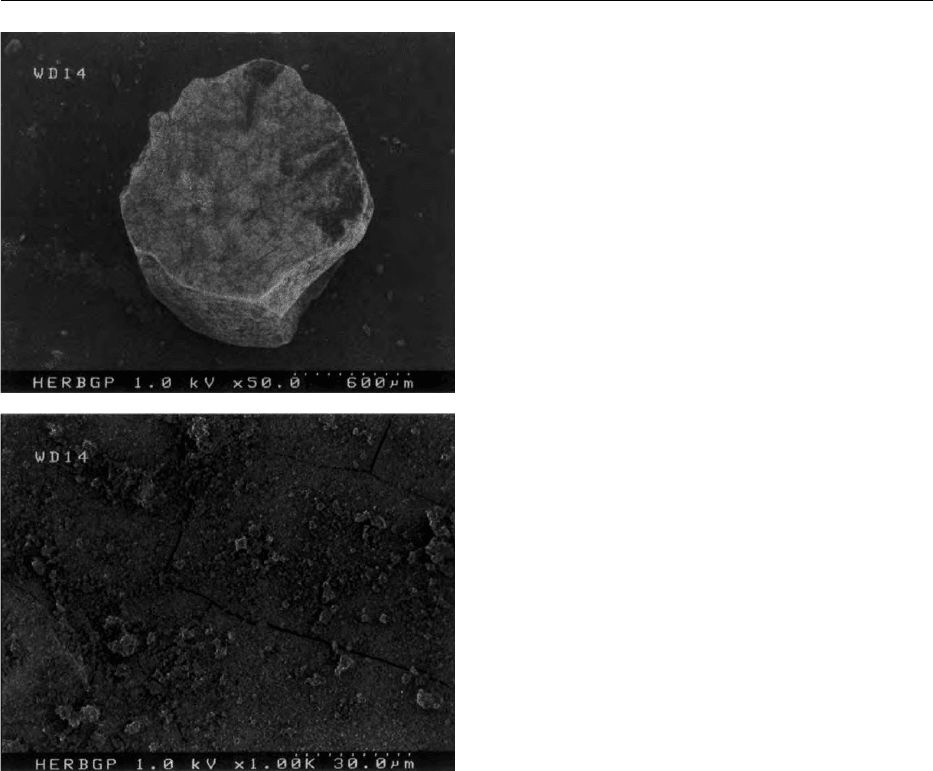
can be added to heat-sensitive oils. Preferred shell
materials are various combinations of sugars, corn-
syrup solids, maltodextrins, modified starches, and
gum arabic, although other shell materials such as
proteins like gluten have been used. In all cases, the
water present in the system at the time of extrusion is
limited to that required to reduce melt viscosity of the
core/shell formulation to a point where extrusion
occurs freely. This is usually no more than 10% of
the mass of material extruded. Extrusion is carried
out under pressure through spinnerets or screw extru-
ders (single and double) with zoned heating. That is,
different parts of the extruder screw and die-head are
at different temperatures.
0037 The shell formulation in the original extrusion pro-
cess was corn-syrup solids containing 3–8.5% water.
Improved properties were obtained by using a corn-
syrup solids shell formulation plasticized with
glycerol, and a further improvement in the process
was achieved by using a mixture of sucrose and mal-
todextrins with a dextrose equivalent of less than 20
(preferably 10–15). This mixture produced particles
with an improved stability towards oxygen and hu-
midity variations.
0038Since the processing temperatures involved in melt
extrusion are relatively high, loss of volatile com-
ponents and oxidative degradation of heat-sensitive
materials are problems that must be addressed.
Accordingly, particle formation and solidification
can be carried out in an extrusion system pressurized
with an inert gas like nitrogen or carbon dioxide. The
final particles are isolated under pressure in order to
avoid loss of volatiles resulting from venting or the
formation of so-called puffed particles with flaws that
cause loss of volatile core material.
0039Suspended nozzles A number of workers have pro-
duced microcapsules by ejecting droplets that contain
a core and shell material from suspended nozzles into
a gas phase, usually air. The droplets pass through a
gas phase until the capsule shell is solidified by
cooling, or they fall into a curing bath where they
are gelled and subsequently harvested. The particles
produced can have a structure like that shown in
Figure 2a or b. In all cases, the rate of droplet pro-
duction and, hence, rate of capsule production is
increased by increasing the number of nozzles,
using centrifugal force, or a combination of these
approaches.
0040Many types of nozzles have been described: single-
fluid, two-fluid, or even three-fluid nozzles. Some are
stationary, whereas others are vibrating or spinning.
They can be single-fluid tubes through which an
emulsion of core material in an aqueous shell solution
flows by gravity extrusion or under an applied
external pressure. Improved control of droplet, and
ultimately capsule, size distribution is accomplished
by vibrating the extrusion tubes or orifices. Single-
fluid tubes usually produce capsules with a structure
like that shown in Figure 2b, since the extruded drop-
lets are dispersions of core material in a solution of
shell material.
0041When droplets are formed by using multifluid
nozzles, each droplet formed contains a continuous
core region surrounded by a liquid shell or by placing
the nozzles in a spinning head through which the
droplets are ejected with the aid of centrifugal force.
The nature of the shell material determines how
ejected droplets are converted into capsules (See
Figure 2b). If the shell material is a relatively low-
viscosity hot melt that crystallizes rapidly on cooling
(e.g., a wax or wax toughened with a polymer), the
droplets are converted into solid particles as they fall
fig0011 Figure 11 Scanning electron photomicrographs of the cross-
sectional surface of a commercial flavor capsule produced
by melt extrusion. Top, 50 magnification; bottom, 1000 mag-
nification. Courtesy Thies Technology.
3900 MICROCAPSULES

away from the nozzle and are cooled. Suitable core
materials are typically polar liquids like water or
aqueous solutions, since they are immiscible with a
range of hot-melt shell materials like waxes.
0042 Alternatively, droplets emerging from the spinning
nozzle may have a shell that is an aqueous solution of
a gelable polymer. In this case, the compound droplets
fall into a gelling bath where they are converted into
gel beads. A specific example is the gelation of an
aqueous sodium alginate shell by an aqueous CaCl
2
gelling bath. The calcium alginate gel beads produced
can be dried to give free-flow capsules. In one previ-
ously documented encapsulation apparatus, com-
pound droplets produced by a vibrating two-fluid
nozzle pass through an aqueous CaCl
2
(20%) mist,
thereby causing a degree of prehardening before the
droplets fall into the actual CaCl
2
hardening bath.
Prehardening minimizes droplet breakage on impact
with the surface of the curing bath.
0043 An understanding of the physical phenomena in-
volved in the formation of microcapsules by nozzle
devices requires an understanding of the principles of
fluid mechanics. Capsules prepared by centrifugal
extrusion tend to be large, with diameters typically
ranging from over 250 mm up to several millimeters.
Capsules produced by stationary vibrating nozzles
can be smaller (e.g., 100 mm in diameter) and very
uniform in size. Atomization can produce much
smaller capsules, although the particle size distribu-
tion can be large, and the capsules may not have a
perfectly spherical geometry.
0044 Spinning or rotating disc In spinning disc encapsu-
lation processes, core material dispersed or emulsified
in a liquid shell formulation is fed onto the center of a
rotating disc. Centrifugal force generated by the ro-
tating disc forces the dispersed core material and
liquid coating formulation across the surface of the
disc to the outer edge. There, the dispersion is thrown
off the disc into a gas phase (usually air) as discrete
droplets. If the core material is in particle form, the
droplets are discrete particles covered with a thin film
of liquid shell formulation. If the core material is an
emulsion or a dispersion of particles in a shell formu-
lation, droplets filled with dispersed core material are
produced. If the shell is a hot-melt formulation, it
cools and solidifies as the particles fall through the
gas phase, thereby producing capsules that can be
harvested and used. If the shell formulation is an
aqueous polymer solution that can be gelled by ions
or a combination of ions and cooling, the coated
particles fall into a liquid-filled curing bath that gels
the shell formulation. The particles with a gelled
coating can be used as gel particles or, in principle,
can be dried to a free-flowing powder.
0045Disc geometry, diameter, and speed of rotation, as
well as volume flow rate of liquid across the disc are
parameters that affect the size of the capsules pro-
duced. In the case of gel beads, surface tension of the
aqueous phase being dispersed in droplet form affects
gel bead geometry. In addition to capsules, one
patented spinning disc process produces particles of
shell material free of core material. In this process, the
disc is operated in such a manner that the particles of
shell material collect in a zone or region distinctly
separated from the capsules and can be recycled. A
variety of hot-melt shell materials can be applied to
dispersed solid particles, but a melt viscosity below
5000 centipoises is favored. Capsule shell formula-
tions that do not solidify rapidly pose problems.
Shell gelled by immersion
in gelling bath
Shell solidifies
by cooling in air
Liquid
core
Liquid
shell
Air
Shell
material
Core material
Shell
material
Gelling bath
Core material
fig0012 Figure 12 Spinning two-fluid drop-forming device used to produce microcapsules.
MICROCAPSULES 3901

0046 Spinning disc processes are claimed to be a fast and
efficient way of producing large amounts of capsules
economically. Claimed sizes of capsules produced in
this manner range from below 100 mm to over 2 mm.
Both solid and liquid core formulations have been
encapsulated. In the case of solid core formulations,
the core material must approach spherical geometry.
Microencapsulated Food Ingredients
0047 A number of food ingredients and additives have been
encapsulated and are available commercially. Micro-
encapsulation holds much hidden potential and
promise for the food industry in the future.
0048 Solid ingredients encapsulated are typically water-
soluble compounds. They are encapsulated with a
hydrophobic or hydrophilic coating material usually
applied by the Wurster process. Preferred hydro-
phobic coating materials are partially hydrogenated
vegetable oils of varying melting points, monoglycer-
ides, and diglycerides. Hydrogenated vegetable oils
used include cottonseed, soybean, and palm. Hydro-
philic coating materials tend to be maltodextrins and
occasionally gum arabic. Both types of coating mater-
ials are well-accepted food-grade products.
0049 Acidulants like citric and lactic acid encapsulated
in partially hydrogenated vegetable oil are used in
meat processing, where they provide direct acidifica-
tion and shortened processing times. Sodium acid
pyrophosphate encapsulated in hydrogenated vege-
table oil is used in frozen cake batters in order to aid
mixing and reduce gas release during batter make-up.
In both types of applications, release of core material
occurs during a heating cycle that melts the shell
formulation and releases the core material.
0050 Acidulants like citric, lactic, and fumaric acids
encapsulated in a water-soluble maltodextrin shell
formulation are used in dry-mix beverages and des-
serts as well as prepared premixes for the baking and
dairy industries. The maltodextrin coating is designed
to minimize hygroscopicity, reduce dusting, and min-
imize reactions with incompatible ingredients. It dis-
solves in the presence of liquid water to rapidly
release the contents of the capsules during a mixing
cycle.
0051 Ferrous sulfate, and vitamin C (ascorbic acid) en-
capsulated in hydrogenated vegetable oil or malto-
dextrin are used to fortify a nutritional product of
some sort. The capsules provide taste-masking, pos-
sibly a degree of prolonged release, stabilization of
the core material against oxidation, and minimization
of reaction with other ingredients in the final product.
0052 Calcium proprionate, and sodium bicarbonate en-
capsulated in hydrogenated vegetable oil are used
in chemically leavened products. Release typically
occurs during the baking cycle as a result of melting
of the hydrogenated shell material. Sodium bicarbon-
ate encapsulated with maltodextrin is used in dry mix
baking and other chemically leavened products. In
this case, release occurs during the mixing step.
Sodium chloride encapsulated in a hydrogenated
vegetable shell is used in various meat products,
yeast-containing mixes, and assorted types of dough.
The capsules are designed to minimize inhibition of
yeast activity, rancidity, and excessive salt binding
during product storage.
0053Liquid food ingredients encapsulated are typically
oil-soluble flavors, spices, vitamins, food oils, and
fats. These core materials are often encapsulated
with a water-soluble shell material applied by spray
drying from water, but fat shell formulations are used
occasionally. Preferred water-soluble shell materials
are gum arabic, modified starch, or blends of these
polymers with maltodextrins and sugars. Vitamins
are encapsulated with zero bloom strength gelatin
by spray drying.
0054A range of spray-dried flavor-filled capsules pri-
marily with water-soluble shell formulations are
used in various dry beverage mixes and other dry
food products. Flavors containing ethyl acetate and
other low boiling point components have been found
to pose problems for successful spray-dry encapsula-
tion. Such components are lost either during the
initial emulsification process or during the actual de-
watering step as a result of azeotrope formation.
Another problem with spray-dry encapsulation is
the formation of free surface oil. The rapid desolva-
tion that occurs in the drying chamber can produce
blow holes in the capsules, thereby essentially leaving
a small amount of flavor oil of free or surface oil that
oxidizes on storage and reduces product quality.
0055Melt extrusion under pressure is an alternate ap-
proach to food flavor encapsulation. Rod-like par-
ticles loaded with a flavor are often produced in this
manner. An advantage of this technology is that it
yields essentially defect-free particles with superb
shelf-life storage stability. A commercial product
(FlavorCell
TM
) has been produced in this manner.
Release data have revealed that the FlavorCell
TM
par-
ticles, when placed in ambient-temperature water,
release their flavor contents as rapidly as spray-dried
capsules that had the same shell formulation. Other
approaches to the encapsulation of food flavors in-
clude complex coacervation and spray chilling.
Summary
0056The food industry is currently incorporating a
number of different microcapsules into a range of
food products. Nevertheless, the volume of capsules
3902 MICROCAPSULES

being sold remains small relative to the huge potential
that exists. Many groups continue to develop encap-
sulation technology and microcapsule-based prod-
ucts for the food industry. For this reason, it is
anticipated that the volume of microcapsules sold
for food use will experience a steady growth for the
foreseeable future.
See also: Chilled Storage: Principles; Drying: Spray
Drying
Further Reading
Achanta AS, Adusumilli PS, James KW and Rhodes CT
(1997) Development of hot melt coating methods.
Drug Devel. Ind. Pharm 23: 441–449.
Balassa LL (1970) Encapsulation of aromas and flavors, US
Patent 3,495,988.
Balassa LL and Fanger GO (1971) Microencapsulation in
the food industry. CRC Critical Reviews in Food Tech-
nology 2: 245–265.
Beck EE (1972) Essential oil composition and method of
preparing the same, US Patent 3,704,137.
Bhandari BR and D’Arcy BR (1996) Microencapsulation of
flavour compounds. Food Australia 48: 547.
Boccio JR, Zubillaga MB, Caro RA et al. (1996) Bioavail-
ability and stability of microencapsulated ferrous sulfate
in fluid milk: studies in mice. Journal of Nutritional
Science and Vitaminology 42: 233–239.
DeZarn TJ (1995) Food ingredient encapsulation. In: Risch
SJ and Reineccius GA (eds) Encapsulation and Controlled
Release of Food Ingredients, ACS Symposium Series 590.
Washington, DC: American Chemical Society.
Franjione J and Vasishtha N (1995) The art and science of
microencapslation. Technology Today.
Gibbs BF, Kermasha S, Alli I and Mulligan CN (1999)
Encapsulation in the food industry. International Jour-
nal of Food Science and Nutrition 50: 213–224.
Hagenbart S (1993) Encapsulated ingredients keep prob-
lems covered. Food Product Design 3: 28–38.
Hincal AA and Kas HS (1994) Preparation of micropellets
by spray congealing. In: Ghebre-Sellassie I (ed.) Multi-
particulate Oral Drug Delivery. New York: Marcel
Dekker.
Jackson LS and Lee K (1991) Microencapsulated iron
for food fortification. Journal of Food Science 56:
1047–1050.
Janovsky C (1993) Encapsulated ingredients for the baking
industry. Cereal Foods World 38: 85–87.
Jones DM and Percel PJ (1994) Coating of multiparticulates
using molten materials: Formulation and process consid-
erations. In: Ghebre-Sellassie I (ed.) Multiparticulate
Oral Drug Delivery. New York: Marcel Dekker.
Lehmann K (1992) Fluidized-bed spray coating. In: Dou-
brow M (ed.) Microcapsules and Nanoparticles in Medi-
cine and Pharmacy, pp. 73–97. Boca Raton, FL: CRC
Press.
Masters K (1991) Spray Drying Handbook, 5th edn. New
York: Halstad Press.
Matsumoto S, Kobayashi H and Takashima Y (1986) Pro-
duction of monodispersed capsules. Journal of Microen-
capsulation 3: 25–31.
Ogbonna JC, Matsumura M, Yamagata T, Sakuma H and
Kataoka H (1989) Production of micro-gel beads by
a rotating disk atomizer. Journal of Fermentation and
Bioengineering 68: 40–48.
Popplewell LM, Black JM, Norris LM and Porzio M (1995)
Encapsulation system for flavors and color. Food Tech-
nology 49: 76–78, 80, 82.
Reineccius G (1995) Controlled release techniques in the
food industry. In: Risch SJ and Reineccius GA (eds)
Encapsulation and Controlled Release of Food Ingredi-
ents, ACS Symposium Series 590. Washington, DC:
American Chemical Society.
Schlameus W (1995) Centrifugal extrusion encapsulation.
In: Risch SJ and Reineccius GA (eds) Encapsulation and
Controlled Release of Food Ingredients, ACS Sympo-
sium Series 590. Washington, DC: American Chemical
Society.
Shahidi F and Han X-Q (1993) Encapsulation of food
ingredients. Critical Reviews in Food Science and Nutri-
tion 33(6): 501–547.
Sparks RE, Jacobs IC and Mason NS (1999) Microencap-
sulation.In: Avis KE, Shukla AJ and Chang R-K (eds)
Pharmaceutical Unit Operations: Coating, pp. 177–222.
Buffalo Grove, IL: Interpharm Press.
Thies C (1995) Microencapsulation, Kirk-Othmer Ency-
clopedia of Chemical Technology, vol. 16, 4th edn,
pp. 628–652. New York: John Wiley.
MICROCAPSULES 3903
